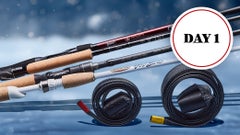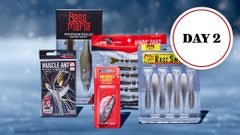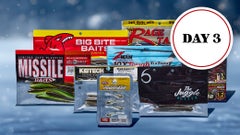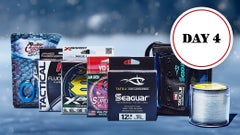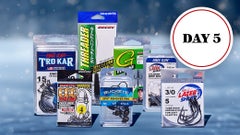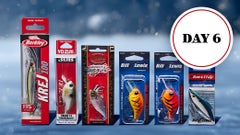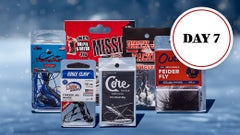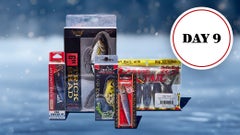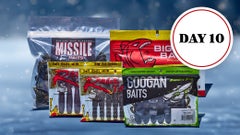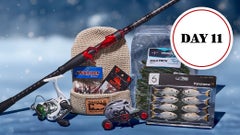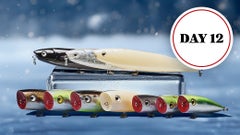Jacob Wheeler Wins BASS Lake Chickamauga
Jacob Wheeler's Winning Pattern, Baits & Gear
Much of practice for Wheeler, like many of his competitors, was spent idling and looking at his electronics in an effort to find as many schools of fish offshore. While there were a lot of fish found and caught shallow, either off docks or out of emerging grass, during the event, the prevailing wisdom was that the winning fish were out off the bank and away from shoreline targets. He already knew of many of the popular community holes that jump off the map and digital charts. His objective, ultimately, was to find those isolated areas where he could pick off a couple good bites a day. Not only would he probably have those spots to himself, it would save him the hassle of having to fish alongside other anglers on river ledges, where current flow is an important factor. "I enjoy fishing off the bank, but I despise fishing in crowds," he said. "I don't confrontation at all. I hate it and I would rather fish for five fish on a spot rather than fish a school of 100 fish with five guys. It's the only thing I hate about ledge events." One place in particular that produced several of his biggest fish during the tournament he never made a cast on in practice. He simply didn't want to be seen there, let alone setting the hook. "I idled over it three times and I knew there was a certain time when the current got right on it," he said. "There wouldn't be a lot of them there, but it was something subtle." He described it as a small depression on a flat and it was deep enough that it created a bit of a current break so the bass could slide in and out depending on the strength of the current. "The shad would group there and it's just a place that had them," he said. "I knew nobody would find it. I'd literally stop 500 yards short of it and then idle over it and never turn around and go back. "People are looking and they're not stupid. If you're idling a ledge and they see you turn around four or five times, they're going to know you saw something. I knew what was there, but I just wanted to check it. I knew how they set up there and they were big ones."
Competition:
With a cloud-filled sky, a good breeze and a fair amount of current, the offshore crankbait bite on day 1 was productive for Wheeler as he caught his three best fish on a Rapala DT-20. He also mixed in the swimbait and came away with 22-06, one of 14 bags of 20 pounds or more and enough to come away in 7th place. He followed that up with a giant stringer that saw him take a 6 1/2-pound lead into the off day. The crankbait bite faded off and he was able to put some good fish in the boat on a 3/8-ounce hair jig along with the swimbait. His big-fish hole kicked out an 8-15 and a 7 1/2-pounder that made up more than half of his sack. He had his best places to himself, by design, on day 2 and overcame a glitch with his front electronics that forced him to watch the screen from the cockpit, throw marker buoys, then target areas that way. Following the off day Friday, he struggled to generate bites on Saturday as he came in with four fish for 16-02, which was good enough to keep him out front, but only by a pound. He avoided fishing his best spot from the first 2 days in hopes to save it for Sunday. He had a 7-07 kicker that saved his day and likely his tournament, and had a couple opportunities to finish his limit, but both times the fish came unbuttoned. "Thinking back, maybe I should have started there," he said. It turned out to be the right decision because the spot he let rest produced a solid 17 1/2-pound limit for him right off the bat on Sunday and allowed him to fish relaxed and mostly stress-free the rest of the day. While his big-fish hole that had produced five giants for him didn't kick out any bass, he upgraded three times after 1:30 to get to 22 pounds, which was more than enough to protect his lead as Matt Herren fell off the pace. "The last day was all about the swimbait and the vibrating jig," he said. He threw the vibrating jig around scattered stumps on a flat.
Winning Pattern:
Wheeler also paid keen attention to brush piles and small rock piles, again areas that weren't holding big schools, but the fish that were there were good-sized bass. "I had three places that nobody else knew about and that was a huge key," he said. "Not only did I have all of the community holes, I also had those subtle little areas. I rotated through some brush piles. Nobody was messing with them and I knew those rock piles or brush would hold one or two fish. I'd go to them and make five or six casts and if I didn't get a bite, I'd move on to the next one. I'd do that after I fished the schools I had. "I think I caught two fish on day 1 doing that and of the 19 I weighed in, I probably caught three total off those places," he added. "It was a big deal to have those places when everybody else was on the same stuff. The thing about fishing the ledges here was everybody was so worried about leaving those places because they couldn't back on them later. I didn't have to worry about that." Wheeler said he had several places that had grass on them, but ultimately didn't fish them. He also fished some docks, but didn't catch any weigh fish there. "I stayed deep the whole time," he said, adding his deepest fish were caught in about 20 feet of water.
Winning Gear:
Swimbait gear: 7'11" heavy-action Okuma Scott Martin TCS casting rod, Okuma Helios TCS casting reel (6.6:1 gear ratio), 14-pound Sufix Invisiline Castable Fluorocarbon line, 3/4-oz. VMC Ike Approved swimbait jighead (white), 6" Basstrix paddletail swimbait (Tennessee shad). Wheeler said the line size was vital to achieving the proper rate of fall and keeping the bait in the strike zone. "12 pound was too light and 17 or 20 was too heavy," he said.
Vibrating jig: 7'3" heavy-action Okuma Scott Martin TCS casting rod, same reel, 17-pound Sufix Invisiline Castable Fluorocarbon line, 3/8-oz. unnamed vibrating jig (white), 4.5" Lake Fork Tackle Boot Tail Magic Shad (pearl).
Crankbait gear: 7'11" medium-heavy Okuma Scott Martin TCS casting rod, same reel, 12-pound Sufix Invisiline Castable Fluorocarbon line, Rapala DT-20 (Ike's Custom Ink disco shad). He didn't get bit on a crankbait in practice, but caught three solid fish on consecutive casts with the DT-20 on day 1 of the tournament. "I got them fired up on the swimbait and then came back with crankbait," he said. He also caught some key keepers on a 3/8-oz. white hair jig.
Main factor: "Without a doubt it was having places that weren't getting pressured. I had multiple places to run to like that and knowing the lake really helped me."
Performance edge: "That Sufix 14-pound fluorocarbon. It was the key to getting bites on the swimbait. You just don't get bites throwing baits on line that's too heavy or too light."
Lake Chickamauga Winning Pattern Bassfan 6/17/14 (Todd Ceisner)
Kevin VanDam's Pattern, Baits & Gear
"That was the day that cost me the tournament," he said. "I had three giants that came off. You don't usually lose them on single-hook baits like that and I did. Those Florida strains living in current, they're healthy and compared to other Tennessee River lakes, Chickamauga does not have the numbers that Guntersville or Kentucky Lake has, but they dang sure have the size. It reminds me of some of the Mexican lakes." When the current slacked off and the bite slowed down, he sometimes picked up a bucktail jig, which is usually used by striper angers. "I went to it when they're weren't pulling water and the fish were suspending," he said. "It pulls good through the water column. That and the (Strike King) Sexy Spoon are my two favorite baits in those situations. The water was a little clearer than usual and I was missing a lot of bites on that spoon. I was fishing the bucktail faster and missed a bunch on that, too, but I also caught some on it." On the final day, he faced a 7-pound deficit to Wheeler, but he had his best day in terms of quantity and weight. He attributed that to the current that was pushing through the lake. "They pulled water pretty good and I knew it would be a problem to make up that deficit without big bites," he said. "It was frustrating (Saturday) because I caught only four fish. (Sunday), I was throwing back 4-pounders left and right. "Current is way more important on those days with high skies and no wind," he added. "We had a lot of diversity as far as the weather and water conditions. You had to adjust each day and Jacob did a good job. Looking back, not one of the leaders was able to stay consistent all 4 days. Jacob and I struggled on Saturday and those big bites he got on day 2 were the difference makers."
Worm gear: 7'6" heavy-action Quantum Exo PT or Quantum Exo Tour PT casting rods, Quantum Exo PT or Quantum Tour KVD casting reels (7.1:1 and 7.3:1 gear ratio), 17-pound EXP fluorocarbon line, 3/4-oz. Mustad swing-head, 6/0 Mustad KVD Grip Pin soft plastic hook, 10" Strike King Rage Thumper Worm (plum).
Jig gear: Same rods, same reels, same line, 3/4-oz. Strike King Denny Brauer Structure Jig (hard candy), Strike King Rage Tail Craw trailer (plum crazy).
Main factor: "Persistence. It wasn't like you could really just pull up and fill the boat. I wasn't getting 50 bites a day. I had to work hard and believe in my areas and sit around. That's not my style, but I knew that's how it was going to be."
Performance edge: "I worked really hard trying to find the right sound pattern on my HydroWave to move the shad and get them activated. There is so much bait on the Tennessee River. There's shad on every ledge and if you can get them moving and pull them off the bottom you can get the bass to follow."
Lake Chickamauga 2-5 Patterns Bassfan 6/18/14 (Todd Ceisner)
Matt Harren's Pattern, Baits & Gear
Football jig gear: 7'3" heavy-action Kistler Z-Bone casting rod, unnamed casting reel, 14-pound Gamma Edge fluorocarbon line, 3/4-oz. Santone Lures M Series football jig (green-pumpkin), Reaction Innovations Twerk trailer (green-pumpkin).
Flipping gear: 7'6" heavy-action Kistler Z-Bone casting rod, unnamed casting reel, 16-pound Gamma Edge fluorocarbon line, 3/8-oz. Santone Lures M Series jig (brown), same trailer.
Shaky-head gear: 7'3" medium-action Kistler spinning rod, unnamed spinning reel, 8-pound Gamma Edge fluorocarbon line, 1/4-oz. Santone Lures Piglet, Reaction Innovations Flirt (green-pumpkin). He also caught some keepers on a 10" worm (red bug) rigged on a 1/2-oz. swing-head jig with a 5/0 Gamakatsu EWG worm hook. "The fish really seem to like that application," he said.
Main factor: "The biggest thing was I had to have what I had to myself. I was fishing a different deal in a different area and was on a different pattern. I wasn't fishing community holes and was by myself."
Performance edge: "The Humminbird 360 Imaging and also the Lakemaster version 2 chip. The Tennessee has been remapped and if you don't have version 2, you're second fiddle. The 360 really becomes a big tool when fishing shell beds. It allows you to look forward and see the ends of the beds."
Lake Chickamauga 2-5 Patterns Bassfan 6/18/14 (Todd Ceisner)
Gerald Swindle's Pattern, Baits & Gear
Flipping/dock gear: 7'4" medium-heavy Quantum Exo Tour PT casting rod, Quantum Tour Mg casting reel (6.3:1 gear ratio), 18-pound Sunline Shooter fluorocarbon line, 3/8-oz. Booyah finesee jig (brown/green), Zoom Z Hog Jr. trailer (green-pumpkin blue flash). Swindle liked the small profile of the jig and trailer combo since he felt that it enticed bites from both smaller and bigger fish, plus it mimicked a bream. "I had to get some 2 1/2-pounders to bite, too, and if you got too big, you could fish your way out of getting a limit," he said. He also weighed a couple fish caught on a Zoom Trick Worm rigged on a shaky-head off some rock piles. He also caught fish on prop baits and some topwaters, but they were smaller and he eventually culled them with out the jig. "It was a simple tournament for me," he said. "I'd come in at night and rig up two rods and go sit down."
Main factor: "Knowing I can't fish in and out and realizing after 17 years that I can't do it. I knew there would be guys doing both, but I told myself, 'I don't want to be that guy who was constantly saying I have to check this hump or ledge.' That mindset helped me. I never questioned my decision."
Lake Chickamauga 2-5 Patterns Bassfan 6/18/14 (Todd Ceisner)
Brett Hite's Pattern, Baits & Gear
ChatterBait gear: 7'3" heavy-action EverGreen Heracles Leopard casting rod, Shimano Chronarch Ci4+ casting reel (6.2:1 gear ratio), 20-pound Sunline Super FC Sniper fluorocarbon line, 3/8- and 1/2-oz. Z-Man ChatterBait (green-pumpkin), 4 1/2" Gary Yamamoto Custom Baits Swimming Senko trailer (green-pumpkin). He alternated ChatterBaits depending on how deep the grass was.
Swimjig gear: 7'1" medium-heavy EverGreen Kaleido Super Stallion casting rod, same reel, 20-pound Sunline Shooter fluorocarbon line, 7/16-oz. unnamed swimjig (green-pumpkin), same trailer (green-pumpkin).
Topwater gear: 7'2" medium-heavy EverGreen Heracles EG Swimming casting rod, same reel, 40-pound Sunline FX2 braided line, 22-pound Sunline Defier Armilo nylon line (leader), EverGreen Shower Blows (skeleton chartreuse).
Football jig gear: Same as swimjig rod, Shimano Metanium casting reel (7.6:1 gear ratio), 16-pound Sunline Super FC Sniper fluorocarbon line, 3/4-oz. EverGreen Modo Reaction football jig (green-pumpkin), Gary Yamamoto Custom Baits double-tail trailer (green-pumpkin).
Worm gear: Same as football jig rod, same reel, same line, 3/8-oz. Reins Tungsten worm weight, 5/0 Gamakatsu offset round-bend worm hook, 10" Gary Yamamoto Custom Baits Kut Tail Worm (plum).
Main factor: "Having the two patterns was by far the biggest factor for me. I didn't want to have all of my eggs in one basket and just knowing it's not like Kentucky Lake where there are tons of ledges, I knew it would be a dog fight. The big schools were on community holes and real obvious stuff, so I knew I'd need to have some back-up plans."
Performance edge: "My Humminbird 360 on the bow. I really like it for fishing grass because it allows me to see what clumps are out in front and what ones are dense."
Lake Chickamauga 2-5 Patterns Bassfan 6/18/14 (Todd Ceisner)




























